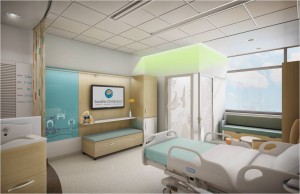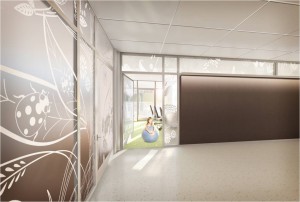
On April 21, Seattle Children’s Hospital will be the first hospital in the country to open an inpatient cancer unit dedicated to teens and young adults. The 16-bed unit will occupy the top floor in the hospital’s new Building Hope facility, which will house inpatient cancer treatment, critical care treatment, and a new Emergency Department.
Teen and young adult patients in the new unit will benefit from the support of their peers, as well as an enhanced package of psychosocial support programs that will improve their treatment experience.
The unit will also be the new home of Children’s Adolescent and Young Adult (AYA) Oncology Program, which was one of the first five cancer programs for teens and young adults in the U.S. Children’s AYA program has been a model for the development of other programs across North America, and will now set the stage for opening a new space for this age group.
“It’s going to be a groundbreaking event in the U.S. to have a unit like this dedicated to teens and young adults,” said Rebecca Johnson, MD, an oncologist at Seattle Children’s. “It presents an opportunity for us to continue with the development of new programs for this age group. Our unit will also provide an example to other institutions of how to deliver quality care for teens and young adults in a dedicated space.”
So why open a unit just for teens and young adults?
Finding a place to belong
Teens and young adults with cancer have different needs and treatment challenges from children or older adults, yet cancer units are typically divided into pediatric and adult care where teens and young adults represent a distinct minority. Johnson says that at the majority of pediatric cancer centers, 90 percent of the patients are under the age of 15, and at most adult cancer centers, 90 percent of the patients are over the age of 40.
“There was no medical home for teens and young adults with cancer,” said Johnson. “In this unit, patients will be able to easily find other patients like themselves and share their experience with a peer, which is very important for AYAs. Being able to interact with someone else their age normalizes their experience and helps them process what they’re going through.”
The difficulty of facing cancer at this age and the need for psychosocial support is something that Johnson understands all too well, not only as a doctor but also as a cancer survivor.
“The cancer experience in itself is isolating, especially for patients in this age group,” said Johnson. “I had cancer in my twenties, and at that time there were no age-specific support services available. It was also hard to locate another person going through cancer therapy who was even close to my own age.”
Johnson explains that peer interactions are important for teens and young adults because they look to one another to see what milestones they should be reaching. Healthy peers are moving forward very fast as they head toward adulthood. If cancer treatment makes patients miss months of school, or key events like graduation and going to college, patients may feel like their whole world has moved on without them, which can be distressing.
“The new unit will allow us to informally get teens and young adults in contact with each other,” said Johnson. “We hope to bring together a peer group, set of acquaintances and possible friends that are all on a similar path. Just knowing that they aren’t alone and can hang out and share their experiences with other patients is something that will be very valuable.”
What new features and programs will be in the unit?

As one of the first AYA programs in the country, Johnson and her team have already done a lot of work to create innovative programs that will improve the lives of adolescent and young adult cancer patients. From the creation of the “Good Times and Bald Times” video series, to offering a Healing Arts Program that promotes healing and provides psychosocial support by helping patients share their stories through creative arts (remember the patient-created “Stronger” music video that went viral?), these programs and more will move into the new unit.
The new space will have unique areas, including an inpatient gathering area and a therapy gym for patients and their families, which will allow for a wide range of daily activities. An AYA psychologist, AYA child life specialist, physical therapists, and other multidisciplinary team members will offer psychosocial programs that will get patients out of their room and engaging with one another.
“Every day there will be a time where patients are invited to come together, like a talking group, Wii tournament, movie night, walks in the unit or activities in the new gym, ” said Johnson. “The important thing will be for patients to see the people around them and form connections.”
An age-appropriate environment
The new unit will also cater to the needs and preferences of teens and young adults.
Johnson says that she is hoping to flex the care patterns in the unit so that they work better for this age group. For example, this may include rounding later in the morning and making quiet/visiting hours later so they are more reasonable for the patients.
Patients’ physical comfort will also be greatly improved as all rooms are private and have much more space and amenities that give patients more control over their environment, which is something Johnson says teens and young adults especially value. A few of the unique features include:
- More space: Rooms are approximately 330 square feet and include bathrooms with showers and room for two parents to stay overnight.
- Patient-controlled temperature and lighting: Patients have the ability to light up glass door panels with multi-color LED lights. Patients and their families can also control room temperature via an in-room thermostat.
- Flat-screen TVs: Each patient room includes a 42-inch television with “Get Well Town,” an interactive Internet-equipped TV entertainment system with access to live and on-demand TV programming, movies and games.
- Personal refrigerators: Rooms include a refrigerator so patients and families can keep their own food and beverages onsite.
Video conferencing pilot study
This summer, Johnson and her team will launch a pilot study of video-conference support groups that will connect teens and young adults treated at Children’s with those at the University of Washington’s Seattle Cancer Care Alliance (SCCA) unit, which also has a large population of young adults who are hospitalized for long periods of time.
This is the first time video conferencing will be used in this way and so a new video conferencing platform is currently being developed. There is a possibility that outpatients will also be able to join in remotely via their phones, iPads or computers.
“We will be examining the feasibility and acceptability of the video-conference support group for teens and young adults who are treated at two different physical locations,” said Johnson. “The study will also broaden the reach of our psychosocial support services to include AYAs treated on the adult side of the SCCA. We will perform preliminary assessments to examine whether the increased psychosocial support improves quality of life and decreases anxiety.”
A growing worldwide focus on teens and young adults
Children’s new AYA unit is one example of the growing worldwide focus on teens and young adults with cancer.
About 70,000 young people ages 15 to 39 are diagnosed with cancer each year in the U.S. However, Johnson explains that the medical community has recently realized that over the past 30 years, cancer survival is not improving for teens and young adults as fast as it has been for children and older adults.
“This obviously points to a need for specific attention to this population to develop more effective treatment protocols,” said Johnson. “In the past five years, there has been a tremendous amount of progress in this field as we work to discover the unique medical needs of this population.”
Teens and young adults comprise a significant population of patients already receiving cancer treatment at Seattle Children’s, where about a fourth of the patients are currently age 15 and older.
So why are AYAs being treated at a pediatric hospital? Research shows that, for certain kinds of cancer, teens and young adults have dramatic improvements in long-term survival when they are treated on pediatric treatment protocols or at pediatric hospitals. For common AYA cancers such as acute lymphoblastic leukemia (ALL) and bone tumors, young adults that are treated on pediatric treatment regimens have a 25 percent improvement in their long-term survival. Children’s also has better outcomes than the national average.
Johnson and her team will continue to focus on conducting research and creating innovative programs and resources specifically for teens and young adults.
“We are committed to improving the lives of teens and young adults with cancer. Opening the first inpatient unit in the country for this age group is an exciting next step in our journey,” said Johnson.
Resources:
- Photos available for download: Hi-resolution renderings of the AYA unit and other Building Hope spaces: http://www.flickr.com/photos/38997016@N03/sets/72157626305241751/
- Read about the experience of one young adult cancer survivor and learn more about Children’s AYA Oncology Program
- National Cancer Institute: Adolescents and Young Adults with Cancer
- Building Hope, Part 1: Top Ten Features of Cancer Inpatient Unit
- Building Hope, Part 2: Early Look at the New Emergency Department
- Building Hope, Part 3: Sustainable and green architecture
- Stupidcancer.org
If you’d like to arrange an interview with Dr. Johnson, please contact Children’s PR team at 206-987-4500 or at [email protected].

